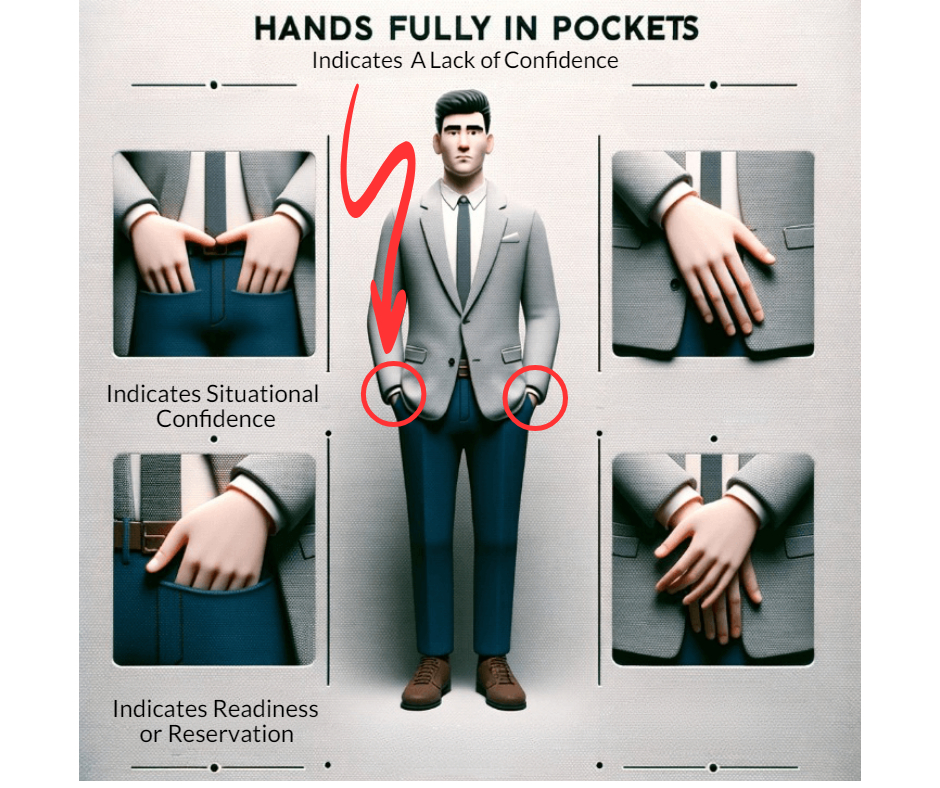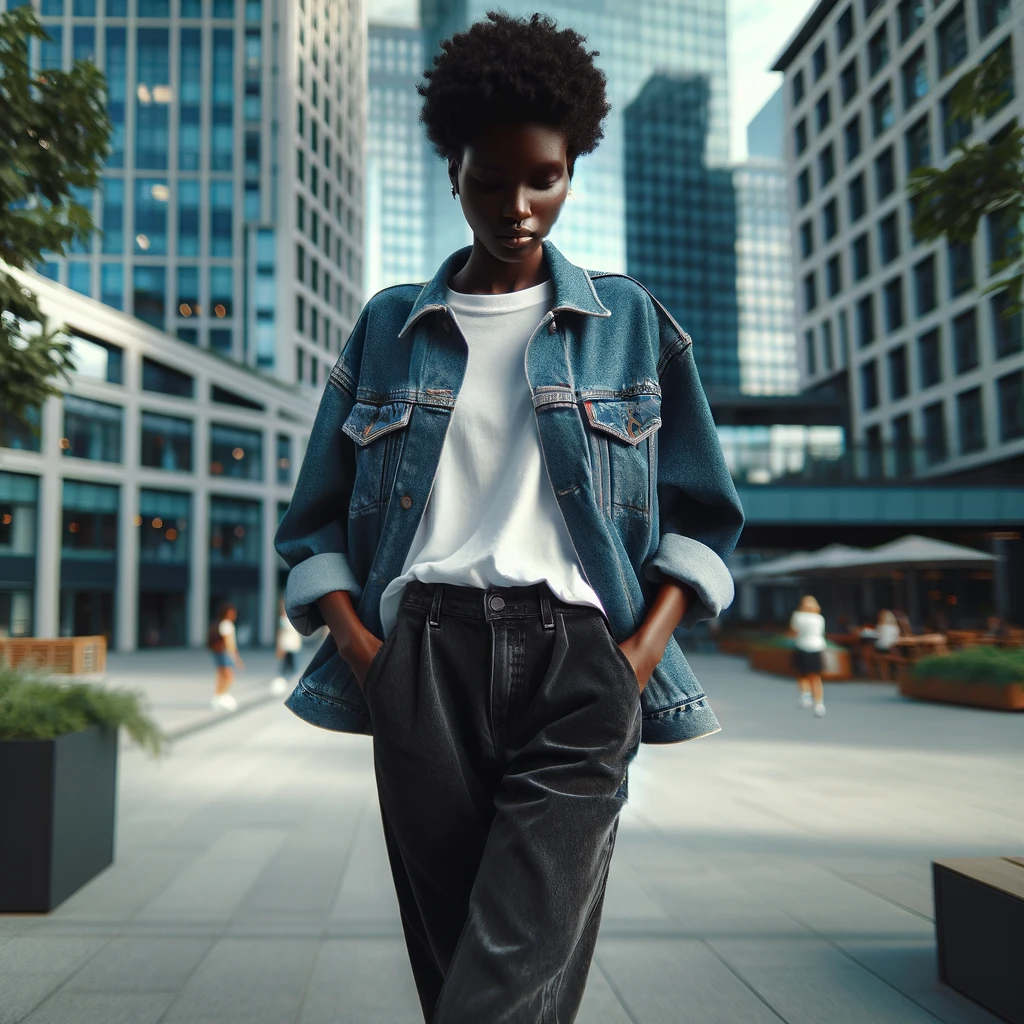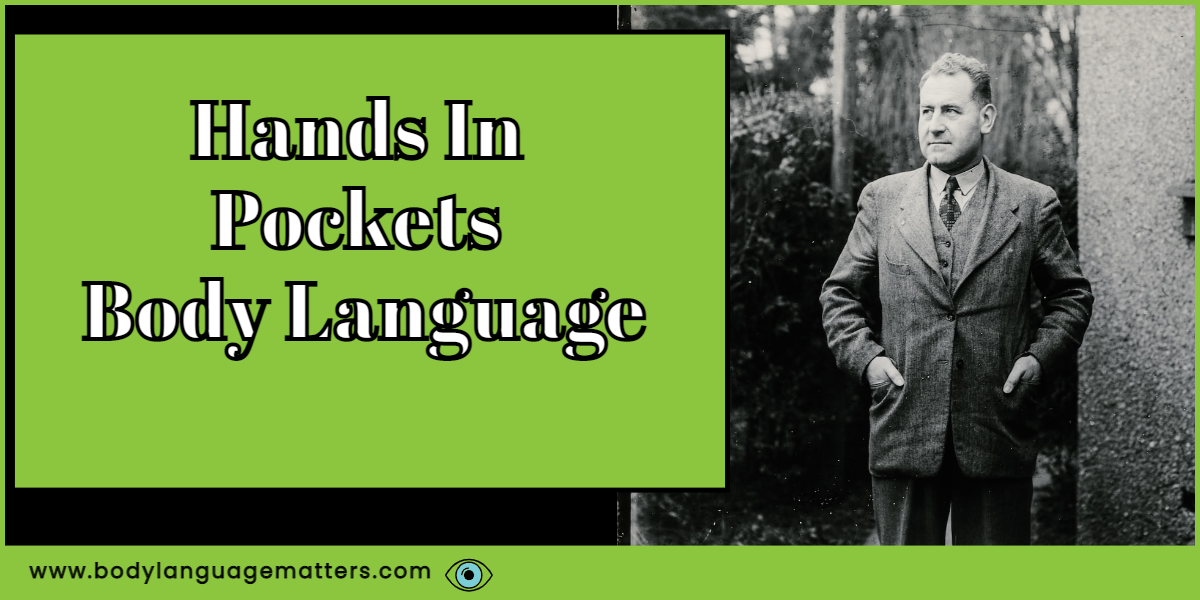Putting your hands in your pockets can mean different things depending on where you are and what’s happening. It’s not enough to just look at one action to understand someone completely.
But, if you notice someone puts their hands in their pockets while they’re talking to you, it’s worth paying attention to. Why did they do that? Let’s look at some reasons.
Usually, when someone puts their hands in their pockets, it might mean they’re feeling unsure, defensive, or not too confident about what they’re saying or doing. Sometimes, it’s as simple as their hands being cold.
However, it could also mean they’re feeling relaxed and comfortable. To really figure out why they’re doing it, think about the situation. What’s being talked about? Are they giving a speech, or maybe flirting with someone? Understanding the situation helps us guess why they’re putting their hands in their pockets at that moment.

Contextual Analysis
Professional Settings

Imagine you’re in a business meeting, and one of the presenters has their hands tucked in their pockets. It can be a tricky read, right? While it might come off as relaxed, there’s a fine line where it can tip into unprofessional territory.
But there’s always a risk – does it make him look confident or too casual? I witnessed this firsthand while attending a seminar for directors. Instantly, you could discern the discomfort of one director compared to the other, simply by observing how they used their hands or where they placed them.
Chae Huges Quote
Subjects sometimes place their hand into their clothing pockets or sit in this positon, and ovement or posturing provide vital clues to their internal thoughts. There three variations in the behavior set.
- Hand in pockets with thumbs inside indicates a lack of confidence, uncertainty, and willingness to show deference.
- Hands in pockets with thumbs protruding or thumbs in pockets with finger out. This indicates situational confidence and (in creation context) sexual availability.
- Hands in the pocket with only fingertips inserted into the opening. This indicates readiness or reservation or both, depending on the context.
More about Chase Hughes can be found at is website
Job Interviews
Picture Sarah, sitting across the table during a job interview, hands in their pockets. It could show she’s at ease, but could it also hint at a lack of preparation? It’s like walking a tightrope – being seen as comfortable versus being perceived as unprepared. It’s all about reading the room! In general we don’t recommend you put your hand in your pockets
Social Scenarios
First Dates

Ah, the jitters of first dates! Now, if Tom keeps his hands in his pockets, is he just laid-back or not that into the conversation? It’s a classic dilemma. Hands-in pockets can be a cool, casual vibe, but it can also send mixed signals. It’s all about the balance, isn’t it?
Parties and Gatherings

At parties, there’s always that one person, hands in pockets, exuding a chill vibe. Take Alex, for example – he’s friendly but has this habit. Some see it as being open and approachable, while others might read it as standoffish. Social cues, they’re a puzzle, aren’t they?
Educational Environments
Classroom Settings

Remember that one professor who’d lecture with hands in pockets? It made them seem easy-going, but some students felt it was a bit too casual for the classroom. It’s interesting how body language can stir up such mixed feelings!
Public Speaking

When Lisa took the stage with her hands tucked away, it was a curveball. Some felt it made her relatable, while others thought it took away from the authority of her speech.
Cultural Contexts
Eastern Cultures
In places like Japan or China, hands in pockets can be a bit of a cultural faux pas. It’s seen as casual, sometimes too casual. This is a great article to read about Eastern Culture and hands in the pockets.
Western Cultures
Out West, it’s a different ball game. Hands in pockets is as common as apple pie. It’s relaxed, easy, but can sometimes be read as aloof. It’s all about the context and setting, a dance between casual and too casual.
Situational Contexts
Celebratory Events
The joy of celebrations! But even here, hands in pockets is a dance of perceptions. Is it a laid-back attendee enjoying the moment or someone detached from the festivities? It’s a melody of silent cues and unspoken narratives! It can be hard to judge just on one piece of body language alone
Quote From The Dictionary of Body Language Written by Joe Navarro
Many people find comfort in placing one or both hands in their pockets while talking to others. However, it is important to note that this can be seen as too informal and, in some cultures, considered rude. Additionally, it should be acknowledged that some individuals mistakenly perceive keeping hands in pockets as suspicious or deceptive.
Find out more about Joe Navarro
Female Body Language Hands In Pockets.

Putting your hands in your pockets can feel either awkward or relaxed, depending on what’s happening around you.
Women often wear pants without pockets, or if they do have pockets, they’re usually tight against the body. So, it’s not common for women to put their hands in their pockets.
If you see a woman doing this, think about why. What’s happening in the room? What was just talked about?
There’s usually a reason when a woman puts her hands in her pockets. Maybe she’s feeling uneasy? You’re in the best position to understand, since you know what’s going on at the moment.
Hands In Pockets Thumbs Out or In.

There are three ways people might use their hands when they’re in their pockets:
- Thumbs Out: This looks friendly and open. It suggests someone feels carefree and confident, like they’re in control.
- Thumbs In: This seems more formal or closed off. It might mean the person is uncomfortable or insecure.
- Thumbs In with Fingers Apart: This can show low status and confidence. Keep this in mind when you see someone standing this way.
You may also like
Hands In Pockets When Walking.

Hands are really good at showing how we feel, especially when they touch other parts of our body. Like, if someone’s hands are touching each other or they’re rubbing their hands, they might be nervous or uneasy.
When someone walks with their hands in their pockets, it can mean different things:
- Relaxed and Leisurely: Like someone strolling on a holiday by the beach, not in a hurry.
- Concealing Something: They might be hiding something, like a package, weapon, or cash.
- Cold Hands: They might just be trying to keep their hands warm.
To figure out why someone’s walking like this, you have to look at the situation and where they are.
Hands In Pockets Head Down

Body language is really strong because it lets us say a lot without speaking. It can show how we feel about someone or if we’re confused, scared, or mad.
In the picture, there’s a man with his hands in his pockets and his head down. This usually means he’s feeling down or depressed. He’s trying to make himself look small.
If you notice someone acting like this, remember it. If you can, maybe check in with them to see if you’re right about how they’re feeling.
One Hand In Pocket Meaning

When a person has one hand in their pocket it could mean a few different things depending on the context of the situation.
For example if someone is leaning up a wall with one hand in their pocket on a summers say they could be trying to look cool or relaxed.
Another example is when someone is walking with one hand in their pocket this could be a sign of dominance as it could be they are trying to conceal a weapon or at least look that way.
Context should give you all the clues you need to understand this gesture.
Hand In Pocket Taking To A Girl Leaning Against A Wall.

When you see a boy or man talking to a girl or woman with his hands in his pockets and one leg up against the wall, this is a strong indication that the boy is attracted to the female.
Putting your hands in your pockets displays a strong side of comfort, depending on the context of the situation. If you’re having an argument, it could mean something totally different.
We really recommend you check our blog on how to read body language to get a full understanding of the meaning.
Hand In Pocket Negative Body Language
People often put their hands in their pockets when they feel defensive, like they’re trying to protect themselves.
Keeping your hands in your pockets can make others think you’re defensive or uncomfortable. It might also seem like you don’t want people to come near you.
In a conversation, putting your hand in your pocket can come off negatively, depending on who you’re talking to.
In an interview, it’s better to keep your hands visible. This shows you’re open and honest, and you can use your hands to help explain your points.
It’s also important not to put your hands in your pockets when talking to the police. They might think you’re reaching for something. If you need to put your hand in your pocket, tell them first and move slowly.
If it’s cold and everyone else is also cold, it’s usually okay to put your hands in your pockets. But if you think it might be misunderstood, it’s better not to. Always read the situation first. It’s better to be safe and make sure your actions won’t be taken the wrong way.
Final Thoughts
Putting your hands in your pocket can mean different things based on your mood, surroundings, and the situation. Some interpretations are positive, while others are negative. The key is to interpret it correctly in the moment. If you found this interesting, you might enjoy reading more about it next time.

